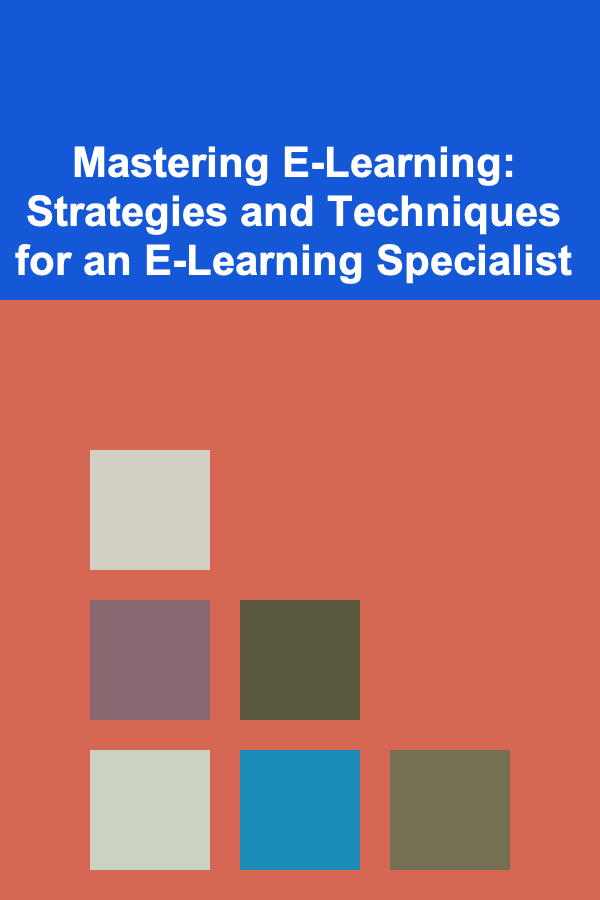
Mastering E-Learning: Strategies and Techniques for an E-Learning Specialist
ebook include PDF & Audio bundle (Micro Guide)
$12.99$7.99
Limited Time Offer! Order within the next:

In the rapidly evolving landscape of education, e-learning has emerged as a powerful tool for delivering knowledge in flexible, engaging, and scalable ways. The role of an e-learning specialist has grown in importance, as organizations, schools, and businesses look to enhance their training and educational offerings through digital platforms. Mastering e-learning is not just about knowing how to use technology; it's about understanding the principles of effective learning, utilizing the right tools, and creating content that engages and educates learners.
This guide will explore the strategies and techniques that every e-learning specialist should master to ensure the success of their online courses, from design and development to delivery and assessment.
Understanding the Fundamentals of E-Learning
Before diving into the specific strategies and techniques, it's crucial to understand the core principles of e-learning. An e-learning specialist should always be grounded in these fundamentals to create impactful learning experiences.
1. Learner-Centered Approach
The heart of effective e-learning lies in designing content that puts the learner's needs, abilities, and preferences at the center. Unlike traditional classroom settings, e-learning allows for individualized pacing, allowing learners to go through the material at their own speed.
- Personalization: Create learning paths that cater to different learner types. Some learners may prefer video tutorials, while others benefit more from reading material or interactive simulations.
- Engagement: Engage learners through varied content formats (videos, quizzes, podcasts, infographics) to prevent monotony. Interactive elements, such as branching scenarios, are particularly effective in keeping learners involved.
2. Clear Learning Objectives
Effective e-learning begins with clearly defined learning objectives. These objectives provide the roadmap for both content creators and learners. Without clear goals, it's challenging to evaluate success or maintain learner motivation.
- SMART Objectives: Use the SMART framework (Specific, Measurable, Achievable, Relevant, and Time-bound) to set clear, attainable goals for each module or course.
- Continuous Assessment: Align your learning objectives with assessments, quizzes, and real-world tasks that check learner comprehension and achievement.
3. Accessibility and Inclusivity
Ensuring that your e-learning courses are accessible to a diverse audience is paramount. Accessibility in e-learning involves considering learners with different needs, including those with disabilities, language barriers, and varying technological capabilities.
- Design for Accessibility: Implement captions for videos, use screen reader-friendly design, and offer materials in multiple languages when necessary. Tools like WCAG (Web Content Accessibility Guidelines) can guide the design process.
- Mobile-First Design: Given the global shift to mobile learning, your content should be optimized for mobile devices. This ensures learners can access courses anywhere, on any device.
Effective Strategies for E-Learning Development
Now that we understand the fundamentals, let's explore practical strategies to create successful e-learning courses.
1. Instructional Design Models
Instructional design is the backbone of any e-learning course. Well-designed courses follow a structured process that ensures content is effective, engaging, and easy to understand. Two widely used instructional design models are:
ADDIE Model (Analysis, Design, Development, Implementation, Evaluation)
- Analysis: Assess learner needs, objectives, and the context in which the learning will take place.
- Design: Outline course structure, create learning objectives, and decide on the content delivery methods.
- Development: Create the actual course content, including writing scripts, recording videos, creating assessments, and integrating multimedia elements.
- Implementation: Deliver the course to learners and ensure they have the necessary tools and resources to access it.
- Evaluation: Continuously assess the effectiveness of the course, gathering feedback from learners, and making improvements for future iterations.
SAM Model (Successive Approximation Model)
The SAM model is a more flexible approach that emphasizes iterative development, where the course is built in short cycles and continuously tested.
- Preparation: Define the project scope, objectives, and resources.
- Iterative Design: Build and test a prototype of the course before developing the full version. This allows you to make adjustments based on feedback.
- Iterative Development: As feedback is gathered from learners, continuously improve the course by making incremental updates.
2. Interactive Learning Elements
One of the greatest advantages of e-learning is the ability to incorporate interactive elements. These elements not only keep learners engaged but also promote deeper understanding and retention of material.
- Quizzes and Polls: Incorporate regular quizzes and polls to assess learner knowledge, reinforce key concepts, and provide instant feedback. Quizzes can also be gamified to increase engagement.
- Simulations: Create realistic, hands-on experiences where learners can practice new skills in a safe virtual environment. This is especially important for technical skills training.
- Scenario-Based Learning: Design interactive scenarios where learners make decisions based on the knowledge they've gained. These scenarios can simulate real-life situations, enabling learners to see the consequences of their decisions.
3. Gamification
Gamification refers to the integration of game mechanics into the learning process. By incorporating elements such as points, leaderboards, badges, and achievements, gamification can make the learning experience more engaging and rewarding.
- Progress Tracking: Allow learners to track their progress by earning points or badges as they complete milestones within the course.
- Competition: Encourage friendly competition by implementing leaderboards that show top performers, motivating learners to excel.
- Challenges: Include timed challenges or puzzles that learners can complete for additional rewards, enhancing both engagement and retention.
4. Mobile Learning Optimization
As mobile devices become more ubiquitous, learners are increasingly accessing e-learning content on smartphones and tablets. Therefore, mobile optimization is critical for ensuring that the learning experience is seamless across all devices.
- Responsive Design: Design courses that adapt to different screen sizes. This might mean simplifying content, ensuring that navigation is intuitive, and testing courses on multiple devices to guarantee usability.
- Offline Access: Offer learners the ability to download content for offline use. This is particularly useful for learners who may not have consistent internet access.
Tools and Technologies for E-Learning Specialists
As an e-learning specialist, selecting the right tools and technologies can significantly enhance the quality of your courses and streamline the development process.
1. Learning Management Systems (LMS)
An LMS is the backbone of many e-learning environments. It provides a platform for course delivery, tracking learner progress, and managing assessments.
- Popular LMS Platforms :
- Moodle: Open-source and highly customizable, Moodle is a popular choice for educational institutions and businesses.
- Canvas: Known for its user-friendly interface and robust features, Canvas is widely used in schools and universities.
- TalentLMS: A versatile LMS with an intuitive interface, designed for corporate training and learning management.
2. E-Learning Authoring Tools
E-learning authoring tools are used to create the actual content of your courses. These tools allow for the development of interactive and multimedia-rich lessons.
- Articulate Storyline: A powerful tool for creating interactive courses. It allows for the creation of scenario-based learning and quizzes, with an easy-to-use interface.
- Adobe Captivate: Ideal for creating simulations and responsive courses, Captivate also supports VR and mobile-friendly content.
- Camtasia: Primarily used for video tutorials, Camtasia is a great tool for screen recording and editing videos for your e-learning modules.
3. Collaboration and Communication Tools
Effective communication and collaboration among teams, instructors, and learners are essential to the success of any e-learning course.
- Slack: A popular communication tool that allows teams to collaborate and exchange feedback in real-time.
- Microsoft Teams: Often used in corporate settings, Teams combines chat, video conferencing, and file sharing to keep communication seamless.
- Zoom: Widely used for virtual classrooms and webinars, Zoom allows instructors to conduct live lessons, discussions, and Q&A sessions with learners.
Assessment and Feedback: Measuring Success
Continuous assessment and feedback are crucial in e-learning to ensure that learners are meeting the defined objectives. Regular assessments help identify areas where learners may be struggling, allowing for timely interventions.
1. Formative Assessments
Formative assessments occur throughout the course and help monitor learner progress. These assessments include quizzes, short-answer questions, and interactive activities. They are not graded but provide valuable insight into learner understanding.
- Instant Feedback: Use quizzes and other assessments that offer instant feedback to learners. This helps reinforce learning in real-time.
2. Summative Assessments
Summative assessments are typically used at the end of a course or module to evaluate learner achievement. These assessments are often graded and can include final exams, projects, or presentations.
- Project-Based Assessments: Encourage learners to apply their knowledge in real-world projects. This ensures they can transfer the skills learned in the course to actual scenarios.
3. Learner Feedback
Gathering learner feedback is essential for improving future courses. Use surveys, polls, and direct feedback sessions to understand the learner's experience, what worked well, and what needs improvement.
- Course Evaluations: Ask learners to rate the course, the materials, and the instructor's effectiveness. Use this data to make data-driven decisions for future course designs.
Conclusion
Mastering e-learning as an e-learning specialist requires a combination of creativity, technical expertise, and an understanding of effective learning principles. By focusing on learner engagement, designing interactive and immersive content, leveraging the right technologies, and continuously evaluating the effectiveness of your courses, you can ensure that your e-learning programs are not only successful but also impactful.
As the demand for e-learning continues to grow, the role of the e-learning specialist will become even more critical in shaping the future of education. With the right strategies, tools, and techniques, you can deliver high-quality educational experiences that meet the needs of modern learners.

How to Build a Smooth Returns Process for International Dropshipping Orders
Read More
How to Build an Emergency Fund Within Your Home Budget
Read More
How to Plan the Ultimate Dinner Party at Home
Read More
How to Store Extra Bedding and Pillows in Small Spaces
Read More
How to Use Natural Elements in Your Holiday Home Decor
Read More
Navigating the Job Market: Strategies for a Successful Recruitment Consultant
Read MoreOther Products

How to Build a Smooth Returns Process for International Dropshipping Orders
Read More
How to Build an Emergency Fund Within Your Home Budget
Read More
How to Plan the Ultimate Dinner Party at Home
Read More
How to Store Extra Bedding and Pillows in Small Spaces
Read More
How to Use Natural Elements in Your Holiday Home Decor
Read More